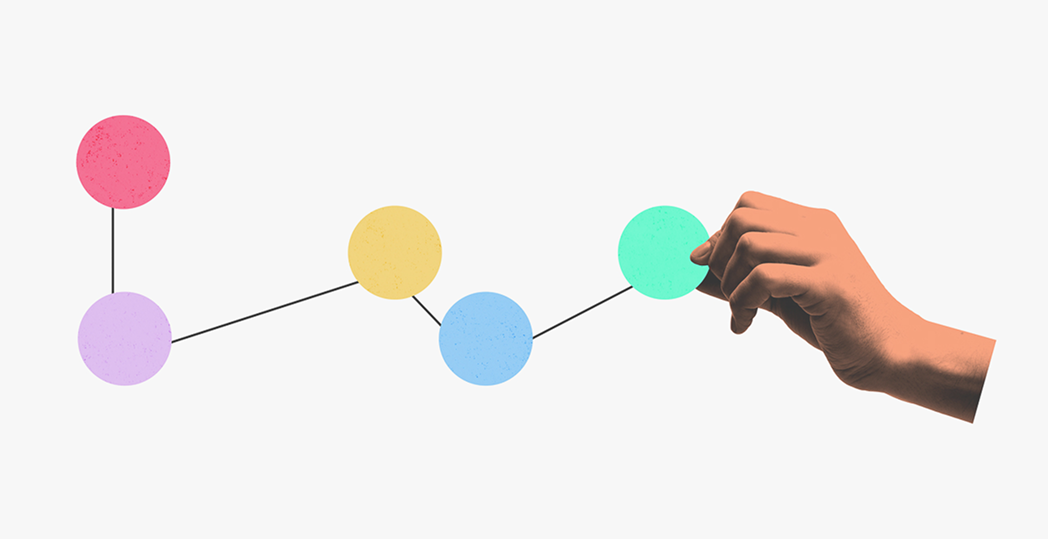As consumers face a daily barrage of ads, content and notifications on every manner of medium, marketers across all types of industries face an uphill challenge in breaking through the noise.
To set their brands apart, they must find ways to deliver effective, innovative campaigns—marketing with real emotional impact, well-coordinated omnichannel touchpoints and strategic targeting.
In a 2024 survey by Insight by Design, senior marketers working across several different industries helped shed light on the value of thinking outside the digital playbook, with insights into direct mail tactics and strategies that work best for them and how mail fits into their larger marketing efforts.[1]
Uniquely tangible, easily connected to digital efforts, and allowing for increasingly precise targeting and tracking, direct mail can help marketers optimize their omnichannel marketing to overcome today’s most important challenges.
Campaigns that tap into customers’ emotions can make a lasting impact, establishing stronger connections that encourage engagement and drive action.
While the slew of daily digital ads can quickly become background noise, direct mail can provide a distinctly personal experience. In fact, research shows that mailpieces engage the brain more deeply than digital media, resulting in stronger emotional responses and better memory retention.[2]
By leaning into the physicality and longevity of direct mail and incorporating the latest mail innovations, marketers can bypass the spam filters and get right to customers’ hearts.
Switch on the senses
Bored with the usual gimmicks and overwhelmed with the constant influx of generic ads, many of today’s consumers are likely seeking more novel experiences. In fact, 74% of consumers think brands should aim to engage all of the senses.[3]
With direct mail, brands can bring special textures, inks, varnishes and even scents directly into customers’ homes. Velvety finishes can bring a sense of comfort and coziness, while embossed lettering can exude sophistication and luxury. More novel innovations like temperature-activated inks that change colors when touched can encourage handling and interaction.
Experimenting with scratch-off or peel-off scented elements can be particularly effective, as the olfactory sense is the most powerful. Because the structure in the brain that processes smell is in the same area that processes memory and emotion, mailers that activate the sense of smell may help brands establish more deep-rooted “human” customer connections.
Specialty inks, textures, die-cuts and even scents can all be used to connect more deeply with customers. Wellness centers may include scented elements that showcase their signature spa scent or aromatherapy options, while a coffee shop may provide a sensory preview of their various roasts. A 4-star hotel or upscale casino may use shimmery, light-reflective inks to exude luxury, while a family-focused hotel catering to theme park guests may send mailpieces that pop up into the shape of a famous park landmark to create a sense of playfulness.
With many of today’s customer experiences taking place in the two-dimensional world of digital, an experience that can actually be smelled and touched can make a lasting impression—and provide the push customers need to take the next step.
In the Insight by Design survey, respondents reported utilizing sensorial direct mail most often toward the end of the customer journey to drive conversion or advocacy.[4] At these final stages of the customer journey, a uniquely tactile experience may get your brand noticed against a sea of easily deleted emails.
Leave an impression that lingers
With tactile marketing now a rarity, most efforts remain fleeting and ephemeral. But unlike digital marketing, direct mail can actually linger physically in customers’ homes on their coffee tables, refrigerators and desks.
In fact, mailpieces are kept in people’s households for an average of 17 days,[5] and 36% of consumers have a specific place in the house where they save print ads of interest.[6] Beautiful, inspiring or useful mailers and add-ons—such as branded calendars, coupon books and postcards with helpful reminders—can all help keep a business top of mind.
In the Insight by Design survey, technology and subscription services companies were by far the most likely to cite staying power as a top benefit of direct mail, at 67%.[7] One of the surveyed marketers—head of marketing for a Wi‑Fi solutions and internet services provider that serves the hospitality sector, senior living centers, student housing and multifamily housing—discussed how she taps into the power of mail’s long shelf life.[8]
For a holiday campaign aimed at senior customers, for example, her company sent out a festive card designed to be saved and displayed; this mailer included a smartphone-scannable QR Code®[9] and a CTA encouraging them to learn how to video chat with their family. The QR Code led right to the brand’s website where they could start a tutorial, helping them make the most of their internet service.[10] With a beautiful design, cheerful holiday message and reminders worth saving, these mailpieces may well have stayed on customers’ fridges or desks for weeks.
One marketer in the retail and consumer packaged goods (CPG) space also mentioned including handwritten notes in their direct mail campaigns to help forge more authentic connections.[11] These kinds of thoughtful touches may remain longer in customers’ homes and also stay longer in their minds.
“[With mail] we have another touchpoint where a customer gets a physical piece that can pass along the energy behind the brand. And this could sit on their table; even if they throw it away after four days, it’s [still been] there to remind them. Whereas when you’re scrolling through [social media], you’re just going to get hit with an ad really quick.”
—Senior CPG marketer[12]
Studies have also shown that even the simple act of touching objects, such as postcards and other mailers, can trigger the “endowment effect”—a term used to describe how people place more value on items in their physical possession. In this way, mailpieces can trigger a feeling of ownership, increasing the chances of customers holding on to them and giving them more attention than they would a digital ad.
Spark household conversations
Many ads get delivered to an individual. Direct mail, on the other hand, gets delivered to an entire household, making it easier to spur group discussions about a brand and its offerings. With 88% of financial, automotive and retail purchase decisions being discussed and finalized at home,[13] marketers who can provide the spark to get these conversations going can increase the chances of interaction. To catch the interest of multiple people within one household, mailers that detail a range of services for different needs—such as beginner savings accounts for young people and retirement options for older people—can make a single mailpiece go further.
The physical quality of mail also offers a big advantage in that it can better foster a sense of trust and security; in the age of constant spam calls and phishing emails, direct mail conveys seriousness and transparency. Research shows that 65% of respondents say they’re likely to engage with direct mail from brands they already know, and less than a quarter of consumers are likely to trust a brand that only engages with them digitally.[14] This can be especially important for brands that depend on reputations of credibility and stability to bring in business and retain customers—such as insurance providers, banks and other financial institutions, and health care companies.
Incorporating some of the sensory elements mentioned above can provide a bit of intrigue to get these mailpieces noticed. A premium credit card promotion embossed with metallic ink can be seen as aspirational while exuding exclusivity. For a savings account aimed at beginning savers, a helpful checklist they can put up on their fridge can make it feel easier to get started.
“Direct mail campaigns have a higher opening rate and reading rate compared with other marketing mediums. [With direct mail] it is easier to attract the attention of our audience.”
—Senior financial marketer[15]
Once customers feel your marketing communications are trustworthy, it’s much easier to move them toward other channels, allowing for better-coordinated marketing across both physical and digital media.
Coordinate and Connect Omnichannel Efforts
Back to toparrow_right_alt
Creating effective omnichannel campaigns with well-timed, well-connected touchpoints can mean the difference between a sale and a loss. In the 2024 Insight by Design research, marketers across several different industries cited bridging physical and digital as a key challenge, particularly at the interest and conversion stages of the customer journey.[16]
When incorporated strategically, direct mail can help create a more complete brand experience and drive engagement across multiple channels, both online and off.
Offer multiple avenues for engagement
Today’s customers pass over a lot of ads. Getting noticed is the first step. Actually keeping customers in your brand ecosystem and drawing them to your other channels is the next. The unique tangibility of direct mail makes step one easier; incorporating the latest digital enhancements into these mail campaigns can help create the better-coordinated, better-connected omnichannel campaigns marketers are after while providing customers with a more enjoyable, seamless experience.
Including a smartphone-scannable QR Code on mailpieces can provide an easy route to digital channels—whether it be a web page, video, social channel or online shop. A health care company, for example, may send a postcard with a QR Code that leads recipients to their online portal, where they can log in to create a personalized health checklist with appointment reminders, specific prescription information, and tailored health and wellness tips.
Personalized URLs (PURLs) can have the same effect. These URLs are customized to each individual customer—often with their first name in the URL—and can lead to a customized landing page tailored to their preferences and behaviors. Not only does this provide a uniquely personal customer experience, but it also creates a seamless path between different channels.
These digital enhancements can be used throughout the entire customer journey, whether at the initial stages to help bring in prospects to an online shop and introduce them to your offerings, or toward the later stages to encourage customers to sign up for a loyalty program or ask them to provide a product review.
Reignite interest with retargeting
To increase the chances of conversion, well-timed follow-ups are paramount. With retargeted direct mail, automated custom mailpieces can be sent out within a few days of a customer taking action on one of your digital channels. This lets you recapture attention at the ideal moment; they may be almost ready to make a move, and your brand will still be in their headspace.
Many companies use this tactic to mitigate online cart abandonment. Out of the various industries surveyed by Insight by Design, those in the hospitality space were the most likely to say that retargeting is an effective marketing tactic, with 56% reporting so.[17]
Cost effective, accessible and nearly impossible to miss, postcards can be an ideal format for retargeting, getting messages across quickly and succinctly. Including an online discount code can provide the extra push customers need to complete the booking; incorporating a QR Code can make it even easier for them to take the final step. For users who’ve added a vacation package to their online cart but stopped short of actually making a reservation, a resort may send a follow-up postcard a few days later, reminding them of the resort’s unique amenities and offering an exclusive discount as incentive.
In the Insight by Design research, marketers reported making use of retargeted direct mail to reach highly specific customer segments; a senior marketer in beauty retail, for example, leverages it to encourage loyalty club members to redeem their rewards.[18] Meanwhile, one e-commerce wine marketer said they turn to mail to reactivate past buyers by delivering long-form, personalized messages and product recommendations based on past purchases. These long-form messages can help give customers a real sense of the story behind the products, helping to forge a stronger connection with the brand.[19] To seamlessly bring these lapsed customers back to their online shop, the wine company could include a PURL, QR Code or smartphone-scannable near field communication (NFC) chip that leads directly to the website.
Studies show that using direct mail in retargeting campaigns can significantly increase return on advertising spend (ROAS) and response rates. The average response rate of direct mail retargeting is 4%, compared with digital ad retargeting at only 0.5%.[20] In one case study, a leading cookware brand using mail retargeting saw an ROAS of over 5x.[21]
The Informed Visibility® feature also makes it easy to connect digital and direct mail marketing efforts, re-engaging customers while a specific message or offer is still top of mind. This free feature allows businesses to track mailpieces throughout every stage of the delivery cycle, beginning with the initial scan at a Post Office™ location. Once marketers get notice of final delivery, they can then launch complementary digital campaigns—whether via email, social, banner ad or text—for the same customers.
This maximizes the impact of each mailpiece, builds familiarity and awareness, and gives people more than one way to respond. The results can be significant: Research shows that reaching the same audience on both offline and online touchpoints can increase conversion rates by more than 65%.[22]
“With direct mail that has a coupon code included, a lot of the time it will spark [customer] interest initially, but then they might forget about it. But if we send a follow-up email that also has the coupon code … we tend to get more traction from that. So that definitely helps—combining the two [mediums].”
—Senior retail/CPG marketer[23]
Experiment with advanced innovations
To take things a step further, incorporating advanced tech like augmented reality (AR)arrow_right_alt into mail campaigns can provide customers with an interactive, novel experience that seamlessly merges the physical and digital realms.
With AR-enabled mailers, customers can place their smartphones over the graphics on the mailpiece in order to activate dynamic 3D images, texts and scenes. These could showcase products, provide a quick how-to or take customers on an immersive tour. For brands with intricate or complex offerings, this can be an ideal way to showcase how products work, what they look like in use or how they can be customized. By including anchor tags throughout this experience, customers can be led to yet another touchpoint, such as an online shop to make a purchase or a form to request more information.
Virtual reality (VR) offers an equally sophisticated bridge from physical to digital media: With the inclusion of an easily assembled, smartphone-pairable cardboard headset in a mailpiece, customers can embark on an exciting, 3D sensory experience—whether showing them what it’s like to drive a new SUV model through beautiful, rugged terrain or giving an immersive tour of a tropical wellness retreat.
Video-in-print (VIP), meanwhile, allows marketers to directly embed small video screens within mailpieces. More than any other industry surveyed, hospitality and entertainment businesses are especially interested in imbuing video-in-print capabilities within direct mail.[24] These videos can provide a unique, immersive experience—whether used to showcase the features of a new car model, give a virtual tour of a wedding venue or provide a visually rich overview of a new software offering. With a whopping 78% of consumers wanting more video from brands,[25] VIP can be highly effective for raising awareness and interest.
Whether leveraging simple QR Codes or cutting-edge 3D experiences, tracking and analyzing how customers interact with these campaigns will be critical to building out customer data and eventually creating even more tailored campaigns.
Create Targeted, Data‑Driven Campaigns
Back to toparrow_right_alt
With today’s marketers under constant pressure to maximize return on investment, they need focused, data-driven tactics that reach the right audience at the right moment. But many brands report struggling with identifying and targeting the right audience, as well as finding ways to measure success.[26]
With ad targeting challenges increasing—including rising digital ad costs, third-party cookie deprecation, and stricter privacy regulations—brands must look beyond traditional digital methods.
When leveraged strategically, direct mail can be used for precision targeting that resonates with individual customers while consistently bringing in high-quality data insights. Of the marketers who increased their direct mail budgets in 2024, nearly 50% cite either the rising cost of competitive media channels or the decreasing availability of data to support online targeting as primary reasons for growing their budgets.[27]
Put personalization into action
To stand out from the competition, marketing must be relevant, targeted and actionable. With the effectiveness of digital ads beginning to decline—and prices continuing to rise—data-backed direct mail can provide the special, personal experience today’s digitally fatigued customers are looking for.
In the Insight by Design survey, marketers from all sectors cited personalization as an important strategy in their marketing toolkit. Across all industries, marketers cited personalization as the top benefit of direct mail campaigns, with arts and entertainment brands (at 71%) and financial services (at 57%) the most likely to cite this as a benefit.[28]
Personalization strategies varied by sector: One marketer in the automotive sector finds success specifically with customized quotes and offers; those in the retail and CPG sector often send personalized product recommendations based on past purchases; and in the health care field, marketers mention striking a balance between tailored content that speaks to individual health needs and adherence to patient privacy regulations.[29]
Trigger-based direct mail offers an easy-to-implement way to leverage first-party data, allowing brands to automate mail campaigns based on specific customer lifecycle triggers—such as birthdays, anniversaries, first purchases or brand loyalty milestones. Personalized mailers may also include enticing promos or discounts to mark the occasion, customized quotes, or recommendations based on past purchases and browsing habits. (First-party data may be spread across various databases and applications; gathering it all into a single customer relationship management, or CRM, system can help keep things organized and provide a more complete view of your customers.)
Working with a digital printer that offers variable data printing (VDP)arrow_right_alt can make it easy to personalize mailpieces at scale. Mailpiece copy, images, design, offers and calls to action (CTAs) can all be tailored to different customers based on their purchase history, loyalty program status and more. VDP also allows for easy activation and deactivation of mail campaigns, resulting in more targeted campaigns as they bring in more up-to-date data.
Taking things a step further, a mailer that includes a PURL with a personalized landing page can be especially effective for high-value or loyal customers, with headlines, CTAs and content blocks customized to their unique habits, history and preferences. This can also bring in copious amounts of data; every interaction on the website can be tracked and analyzed to see what the customer clicked on, how long they browsed, what they skipped and so on. These findings can then be used to shape future campaigns that provide an even more relevant, hyperpersonalized experience.
Don’t let local customers slip away
While local marketing is often viewed as a Main Street business tactic, it can also be very beneficial for companies with multiple locations or regional identities. By targeting specific ZIP Code™ locations, marketers can deliver tailored messages to customers in specific areas. This can be an ideal way to expand your customer base and build affinity for your brand.
Out of all the marketers surveyed by Insight by Design, those in the tech/subscription services and automotive industries were by far the most likely to report targeting local customers, at 83% and 71%, respectively.[30]
The Every Door Direct Mail® (EDDM®) online tool can be valuable for geographic targeting, allowing marketers to target entire neighborhoods, ZIP Codes or carrier routes. This can be a very cost-effective way for certain segments of the auto industry—such as maintenance and repair service providers, tire shops and car washes—to reach every prospect in a certain neighborhood.
Because the EDDM tool is based on U.S. census data, marketers can select specific routes that best match their demographic criteria—filtering by age range, household size and income level. For a campaign focused on first-time car buyers, this may mean zeroing in on younger consumers in a selected geographic area. EDDM makes it easy to create tailored campaigns at scale and does not require renting or purchasing address lists, which can be costly.
Considering that Americans are willing to spend an extra $150 a month on average to make sure their local shops survive,[31] dedicating even a small amount of your marketing budget to local campaigns can come with big rewards.
Put a spin on traditional mail
Even the most straightforward, least creative direct mail—bills, invoices or appointment reminders—can be turned into data generators by combining them with simple digital tools.
With the Informed Delivery® featurearrow_right_alt, brands can provide three distinct, tailored touchpoints to interact with:
- A free digital preview of incoming direct mail, viewable via email or the online dashboardarrow_right_alt.
- The mailpiece itself, delivered to the customer’s mailbox.
- Any “ride-along” content—related digital content—brands choose to include as a link along with the digital preview. This link is displayed as a full-color image of the marketer’s choice. For example, if a postcard is advertising an upcoming clothing sale, the ride-along content may include an image of popular items with bold “40% off” text and link directly to the online shop where customers can browse.
These campaigns offer a simple and accessible way to gain valuable data that can help optimize your marketing spend—assessing which ride-along content is clicked on most often, how users engage with the content, and how many users took action or made a purchase.
The Informed Delivery feature is also an ideal conduit for A/B testing, helping companies better understand their customers and what motivates them. As an example, if a tech company sends out a mailpiece advertising a new software platform, two different versions of the ride-along content could then be delivered along with the mailpiece preview—one highlighting a free trial and one highlighting a discounted rate. By connecting the different ride-along content versions to two distinct landing pages, brands can easily track how many people responded to each offer.
Key Takeaway
To meet today’s varied challenges, stay competitive in a saturated market, and gain the attention—and loyalty—of today’s discerning customers, savvy marketers are always on the lookout for fresh tactics and innovations.
Finding ways to evoke customer emotion, coordinate digital and physical marketing, and create data-driven, targeted campaigns can help brands optimize their omnichannel campaigns and stand out from the crowd.
To tackle these challenges, brands across various industries—from automotive to health care to CPG—are incorporating a time-tested physical medium into the marketing mix: direct mail.[32] Uniquely intimate and tangible, easily connected to other channels, and allowing for increasingly precise targeting and data gleaning, direct mail is full of possibility for the future-forward marketer.

 search
close
menu
search
close
menu


